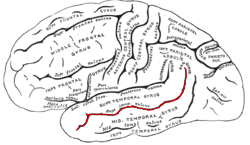Superior temporal sulcus
| Superior temporal sulcus | |
|---|---|
 |
|
 |
|
| Details | |
| Part of | Temporal lobe |
| Identifiers | |
| Latin | sulcus temporalis superior |
| Dorlands /Elsevier |
g_13/12405536 |
| TA | A14.1.09.145 |
| FMA | 83783 |
|
Anatomical terms of neuroanatomy
[]
|
|
The superior temporal sulcus is the sulcus separating the superior temporal gyrus from the middle temporal gyrus in the temporal lobe of the brain. The superior temporal sulcus is the first sulcus inferior to the lateral fissure.
Recent studies reveal multisensory processing capabilities. Research has documented activation in the STS as a result of five specific social inputs, and thus the STS is assumed to be implicated in social perception. It showed increased activation related to: voices versus environmental sounds, stories versus nonsense speech, moving faces versus moving objects, biological motion, and theory of mind (false belief stories versus false physical stories). It is involved in the perception of where others are gazing (joint attention) and is thus important in determining where others' emotions are being directed.
In individuals without autism, the superior temporal sulcus also activates when hearing human voices. It is thought to be a source of sensory encoding linked to motor output through the superior parietal-temporal areas of the brain inferred from the time course of activation. The conclusion of pertinence to vocal processing can be drawn from data showing that the regions of the STS (superior temporal sulcus) are more active when people are listening to vocal sounds rather than non-vocal environmentally based sounds and corresponding control sounds, which can be scrambled or modulated voices. These experimental results indicate the involvement of the STS in the areas of speech and language recognition.
The majority of studies find it is the middle to the posterior portion of the STS that is involved in phonological processing, with bilateral activation indicated though including a mild left hemisphere bias due to greater observed activation. However, the role of the anterior STS in the ventral pathway of speech comprehension and production has not been ruled out. Evidence for the involvement of the middle portion of the STS in phonological processing comes from repetition-suppression studies, which use fMRI to pinpoint areas of the brain responsible for specialized stimulus involvement by habituating the brain to the stimulus and recording differences in stimulation response. The resultin g pattern showed expected results in the middle portion of the STS.
According to the audiological pathway model supplied by Hickok and Poeppel, after the spectrotemporal analysis conducted by the auditory cortex, the STS is responsible for interpretation of vocal input through the phonological network. This implication is shown in the activation of the region in tasks of speech perception and processing, which necessarily involves access to and continuance of phonological information. By manipulating the interactions of phonological data, represented by the provision of words with high or low neighborhood density (words associated with many or few other words), the fluctuation of activity of the STS region can be seen. This changing activation links the STS with the phonological pathway.
...
Wikipedia
